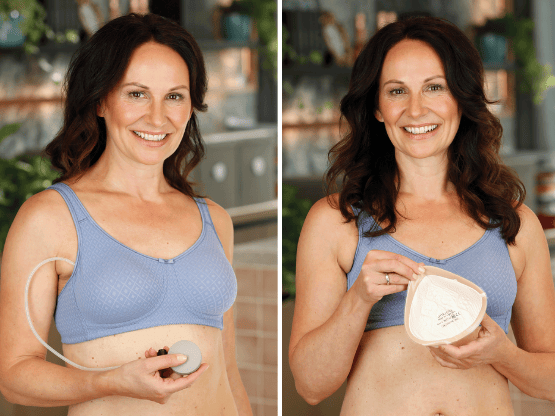Comfort During Radiation
Top tips to keep your skin healthy and your mind strong during radiation therapy
 What You Need To Know:
What You Need To Know:
Your doctor is recommending radiation therapy as part of a comprehensive cancer treatment program. Typically, this treatment may include surgery, chemotherapy and radiation therapy. Radiation therapy is usually the last phase of cancer therapy, and can be a time when you feel closure regarding the treatment of your disease.
Your personal radiation treatments will be based on careful review of your pathology information that will identify the type of breast cancer, size of the cancer, location and other prognostic information that will help your medical team plan your care.
Everyone is different and everyone’s body has individual responses to the therapy, but there are some general reactions that can be addressed with a little forethought and care.
First Things First: Types of Treatment
External Radiation Therapy
If you had breast surgery, you will most likely receive external radiation. The process begins with the simulation process, which pinpoints the exact area to be treated. You will lie on a table while the radiation technologist uses a special diagnostic xray machine to define your treatment “field” or “port.” A special mold will be made to help you remain in the same position during each treatment. This area will be marked with colored, semi-permanent ink on your skin. It is important that these marks not be washed off while bathing.
Using the information from the simulation, other tests and your medical history, your radiation oncologist will meet with the radiation physicist and other members of the radiation oncology staff to determine your individual treatment plan. Generally, this type of radiation therapy is given 5 days a week for 5 to 6 weeks. Your doctor should discuss your individual treatment plan before your treatment begins. Since treatment takes place daily, during the week, negotiate a time of day with your doctor that will be convenient for you and your family.
Internal Radiation Therapy
If you had breast conserving surgery, you may be a candidate for two newer forms of targeted internal radiation therapy.
These systems use an inflatable catheter or a spherical applicator inserted into the surgical area at the time of surgery or within six weeks. The advantage to these systems is that the number of required treatments, and therefore the length of treatment, is greatly reduced.
As treatment for breast cancer, external radiation therapy does not cause you to become radioactive. There is absolutely no risk to others of radiation exposure. If you have internal radiation, you may be isolated in a private hospital room during the treatment. You do not remain radioactive after the seeds and catheters have been removed.
Radiation Side Effects On Your Skin
Skin changes from radiation therapy are temporary, not too different from a mild to moderate sunburn. Within 3 to 4 weeks of treatment, you may experience increasing redness, dry, peeling and itchy skin. Occasionally, the skin may become moist and “weep,” especially in the areas of skin folds.
If you’ve had breast conserving surgery, you may notice changes in your breasts. The skin may become darker and the pores enlarged and more noticeable. You may experience increased or decreased skin sensitivity, breast tenderness or tightness and the skin may feel thicker. The breast may become larger due to fluid buildup or smaller due to fibrous tissue. These changes may continue for a year or longer after treatment.
Feeling your best after radiation therapy

It’s a good idea to be professionally fitted for a new bra after radiation therapy, because your bra size may have changed. If you are concerned about breast asymmetry, you can enhance your silhouette by wearing a full or partial shaper. Amoena Balance products come in several sizes, shapes and thickness levels that will help even out your figure. Most insurance plans and Medicare cover post-breast surgery bras and silicone shapers or breast forms. Check with your insurance plan to find out what is reimbursed.
Caring For Yourself
Body and mind work together to heal. Here are a few helpful hints to ease the effects of radiation therapy.- Bathe in tepid, rather than hot water.
- Don’t rub your skin. Be gentle. Pat yourself dry.
- Don’t wear tight, constricting clothing or tight bras.
- Wear breathable, natural fabrics, such as cotton.
- Check with your radiation doctor or nurse before using any medicines, powders, creams, perfumes, ointments, lotions or home remedies during your treatment and for several weeks afterward.
- Don’t use adhesives, medical bandages or medicated patches on your chest.
- Discontinue the use of deodorant.
- Don’t use heating pads or ice packs on treated skin.
- Avoid sun exposure on your chest during treatment and for one year after treatment completion.
- Report any skin changes to your radiation doctor or nurse.
For Peace of Mind
- Don’t feel you have to continue doing all the things you normally do.
- Plan activities based on their importance to you and perform them at the time of day you feel best. Radiation can sometimes also cause fatigue.
- Ask family or friends to help with daily chores (shopping, cooking, childcare).
- Maintain some level of regular activity, but do not exhaust yourself with strenuous activity.
- Take time to relax. Perform an activity that you enjoy, such as reading, listening to music and meditating.
- Eat nutritionally balanced foods, including fruits, vegetables, whole grains and lean meats.
- Eat light snacks throughout the day rather than three heavy meals.
- Rest during the day; try to get more sleep at night.
- Remember, any fatigue you may feel during treatment is temporary.








